People who connect with nature are happier, and children who connect with nature are more prosocial and better-behaved. How can we help our families feel a greater sense of connectedness?
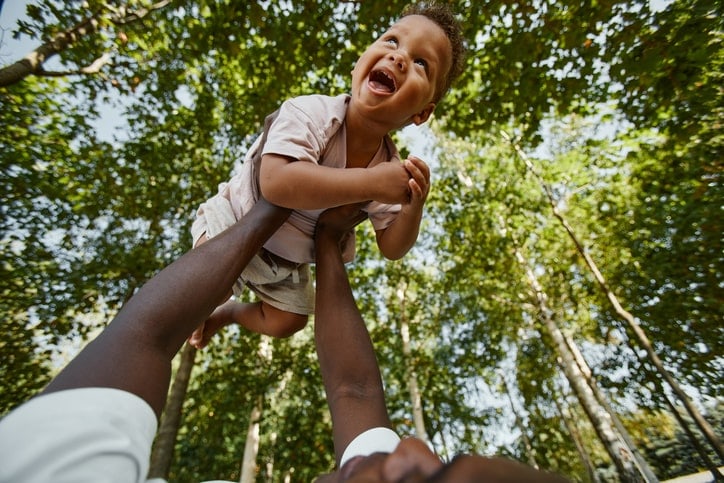
You already know that kids benefit when they play outdoors. They also reap special benefits when they spend time in nature. We all do. And research suggests it isn’t just a matter of spending time — of being there, being physically present.
- Kids who feel an emotional, psychological connection with nature tend to have fewer behavior problems.
- They are more “prosocial” — more likely to show sympathy for others, more likely to offer a helping hand.
- And, like adults, children who connect with nature tend to feel a greater sense of happiness and well-being.
Read more about it in my article, “Kids who feel connected with nature are happier — and better-behaved.”
But here, let’s focus on the practicalities. What can we do to help our families feel a greater sense of connectedness to nature?
How to connect with nature: 12 tips
1. Got a young child? Start now.
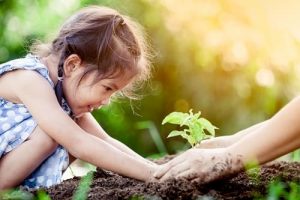
The evidence is pretty consistent. Adults who feel strongly connected with nature are more likely to have experienced lots of contact with nature as children. And research suggests that kids find it easier to forge a connection with nature when they are younger — i.e., before the age of 10 or 11 (Bruni and Schultz 2010; Leiflander et al 2013).
2. Don’t wait around for the perfect trip to the Great Outdoors. Find opportunities for everyday nature encounters, however humble.
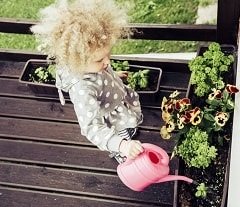
If you live in the city — or lack access to a private backyard or garden — you might feel that “visiting nature” means traveling to a major attraction. But should you wait around until you have the opportunity to make such trips?
No. Frequent contact with nature is important, and research confirms that kids can form strong connections with nature even if they live in high-rise apartment buildings (Sobko et al 2018).
So it doesn’t make sense to wait until you can plan the perfect trip to a special beauty spot. Don’t let the perfect be the enemy of the good!
Visiting your neighborhood park is helpful, even if it offers only a grassy field, or a stand of trees. And when you can’t make it to the park? Your child can benefit from monitoring a small container garden.
3. Help your family tune into nature with interactive, goal-based activities — like bird feeding, bird watching, keeping a nature journal, or going on a “bug safari.”
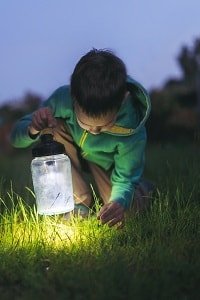
To really connect with nature, we need to pay attention to our environment. But what if kids are slow to engage, or don’t seem interested? Grab their attention with activities that require close observation — and a goal.
For example, research suggests that people feel more connected with nature when they feed local birds (Cox and Gaston 2016). And kids have become more involved after engaging in daily wildlife monitoring, like bird-watching, and taking tallies of the different species they’ve spotted (White et al 2018).
In the same way, your child might benefit from going on a “bug safari” (a quest to find different kinds of insects), or a hunt for interesting rocks, seeds, or pine cones.
For more ideas, see this Parenting Science guide to animal tracking activities for young children.
4. Teach kids how to be considerate and respectful of nature.
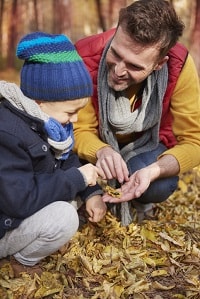
Being outdoors is a great opportunity for a child to be boisterous, and make no mistake: Kids thrive when we provide them with open spaces to run around and explore.
But kids also need to learn basic guidelines for behaving with consideration, compassion, and respect. Indeed, as I explain elsewhere, researchers regard empathy for nature and respect for nature as essential for experiencing a strong sense of connectedness to nature.
So we should teach kids how to share spaces with other visitors and wildlife.
- Teach kids about the harm caused by littering and pollution.
- Teach children that trees are alive; damaging them makes them more vulnerable to pests and disease.
- Explain why it’s important to stay on a marked trail — and out of environmentally-sensitive areas.
- Remind kids that animals should be treated with respect; don’t allow kids to harrass them.
- Show kids when and how to use their “quiet voice.”
5. Communicate nature experiences — through writing, photography, and other arts

Research suggests that we feel more deeply connected to nature when we share our nature experiences with others (McEwan et al 2019). And kids may reap special benefits when they express their ideas creatively.
For instance, kids may develop greater feelings of connectedness by working outdoors on nature-inspired art projects — drawings, paintings, sculptures, stories, videos, or photoessays (Moula et al 2022; Bruni et al 2017).
6. Learn how to identify the local wildlife.
City dwellers are often unaware of the biological diversity around them, and that’s a barrier: People are more likely to feel connected with nature when they are familiar with the species they encounter.
For example, in a study of people living in the U.K., researchers found that individuals had more positive responses to birds when they could identify different species, and something about the birds’ behavior (Cox and Gaston 2015).
So don’t just send kids outdoors. Provide them with opportunities to learn about wildlife. Look for online guides to the biodiversity in your area. If you’re in the U.S., check out the National Wildlife Federation’s nature guide apps.
And here’s an enthusiastic recommendation from me: Merlin, the mobile phone app that will help you identify and record local bird species. Created by the renowned Cornell Lab of Ornithology, this app is “designed to be a birding coach for bird watchers at every level.” My favorite feature is “Sound ID,” which “listens” to the bird sounds you record and actually identifies them! Learn more about this app, and download it for free, from the official Cornell University Merlin website.
7. Learn how to protect local wildlife.
Getting involved with local conservation doesn’t just help the environment. It can also help us deepen our feelings about nature. But what sorts of things can we do?
- Pick up litter.
- Help plant native trees in your community.
- If you are fortunate enough to have a private outdoor space, create a garden that is friendly to wildlife. For guidance, see these pages — with links to detailed articles — from the Natural Wildlife Federation (USA) and the Royal Society for the Protection of Birds (UK).
- Participate in local rescue projects — saving creatures that are under direct threat from human-made infrastructure.
Kids can help with each of these, and the experiences are likely to boost their environmental awareness and empathy for wildlife.
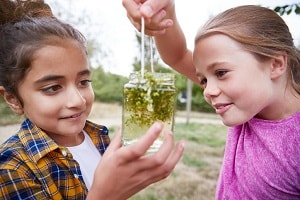
For instance, in an elementary school in Sweden, 5th graders participated in an 8-week project to rescue amphibians from a human-made hazard.
The students learned about the ecology and behavior of a local salamander species. They also took turns searching for, and transporting, salamanders that were trapped in a dried-up, concrete wading pool. How did this affect the participants?
Immediately after completing the project — and in interviews conducted two years later — kids said the project made them feel more empathy and concern for the salamanders. They also reflected that the project had helped them understand the importance of nature (Barthel et al 2018).
8. Participate in citizen science!
Around the world, scientists are benefiting from data collected by everyday people, and some of the most interesting opportunities are in ecology and the environment (Fraisl et al 2022).
National Geographic has rounded up a number of real-life science projects that your family can volunteer to help with. Check them out here.
9. Weird weather? Seize the opportunities to learn about meteorology.
Extreme or uncomfortable weather can keep kids cooped up inside, and make it harder for them to connect with nature (Talebpour et al 2020). But it can also be an opportunity to pique your child’s curiosity, and learn about the science of weather. Get an outdoor thermometer. Make this homemade weathervane (PBS Kids). Measure rainfall with this DIY rain gauge (NOAA). Keep a weather log. And — for older kids — check out the weather-related activities, games, and video tutorials on SciJinks (NOAA).
10. Going to visit a new place? Give your child a preview first.
Going to a new beach? A cool waterfall? A mountain trail? A scenic gorge? The Grand Canyon?
Whether it’s a local beauty spot, or a major world attraction, give your kids the opportunity to look and learn before you visit. Help kids learn what to expect — what’s exciting and interesting about this location. What plants and animals can you expect to find there? What geological features exist, and how were they formed?
You can find images and information in books, but look, too, for images and videos online. Learning in advance builds anticipation. It will also make your visit more enjoyable.
11. Stop staring at your phone.
Folks who are really preoccupied with their cell phones – and who use their phones as an escape from negative feelings – are less likely to experience feelings of connectedness with nature (Richardson et al 2018).
12. What if you can’t get outdoors? Know that just looking out the window — or watching beautiful nature programs — can deliver benefits.

To enjoy the positive psychological benefits of nature, you don’t have to be outdoors. As I explain elsewhere, researchers have shown that just looking at scenes of nature can help.
So when you’re stuck indoors, don’t give up on nature experiences. Expose your child to exciting nature documentaries and photographs. And if you’re lucky enough to have a window view of nature, take the time to enjoy it.
More reading about the benefits of contact with nature
Check out these Parenting Science articles on related subjects:
- Green spaces benefit mental health (an in-depth look at the evidence)
- 12 benefits of outdoor play (includes practical takeaways for making the most of your child’s time outside)
- Outdoor learning and green time (explains how kids benefit from learning and playing in nature)
References: How to connect with nature
Barrable A and Booth D. 2020. Increasing Nature Connection in Children: A Mini Review of Interventions. Front Psychol. 11:492.
Barrera-Hernández LF, Sotelo-Castillo MA, Echeverría-Castro SB, Tapia-Fonllem CO. 2020. Connectedness to Nature: Its Impact on Sustainable Behaviors and Happiness in Children. Front Psychol. 11:276.
Barthel S, Belton S, Raymond CM, Giusti M. 2018. Fostering Children’s Connection to Nature Through Authentic Situations: The Case of Saving Salamanders at School. Front Psychol. 9:928.
Brom P, Anderson P, Channing A, Underhill LG. 2020. The role of cultural norms in shaping attitudes towards amphibians in Cape Town, South Africa. PLoS One. 15(2):e0219331.
Bruni CM and Schultz PW. 2010. Implicit beliefs about self and nature: Evidence from an IAT game.Journal of Environmental Psychology 30(1): 95-102.
Bruni CM, Winter PL, Schultz PW, Omoto AM and Tabanico JJ. 2017. Getting to know nature: evaluating the effects of the Get to Know Program on children’s connectedness with nature. Environmental Education Research, 23(1), 43–62.
Capaldi CA, Dopko RL, Zelenski JM. 2014. The relationship between nature connectedness and happiness: a meta-analysis. Front Psychol. 5:976.
Ceríaco LM. 2012. Human attitudes towards herpetofauna: the influence of folklore and negative values on the conservation of amphibians and reptiles in Portugal. J Ethnobiol Ethnomed. 8:8.
Cox DT and Gaston KJ. 2016. Urban Bird Feeding: Connecting People with Nature. PLoS One. 11(7):e0158717.
Cox DT and Gaston KJ. 2015. Likeability of garden birds: Importance of species knowledge and richness in connecting people to nature. PLoS One. 10(11):e0141505.
Duron-Ramos MF, Collado S, García-Vázquez FI, Bello-Echeverria M. 2020. The Role of Urban/Rural Environments on Mexican Children’s Connection to Nature and Pro-environmental Behavior. Front Psychol. 2020;11:514.
Fraisl D, Hager G, Bedessem B, Gold M, Hsing P-Y, Danielsen F, Hitchcock CB, Hulbert JM, Piera J, Spiers H, Thiel M and Haklay M. 2022. Citizen science in environmental and ecological sciences. Nat Rev Methods Primers 2: 64.
Joye Y and Bolderdijk JW. 2015. An exploratory study into the effects of extraordinary nature on emotions, mood, and prosociality. Front Psychol. 5:1577.
Liefländer AK, Fröhlich G, Bogner FX, and Wesley Schultz P. 2013. Promoting connectedness with nature through environmental education. Environmental Education Research, 19:3, 370-384,
Lumber R, Richardson M, Sheffield D. 2017. Beyond knowing nature: Contact, emotion, compassion, meaning, and beauty are pathways to nature connection. PLoS One. 12(5):e0177186.
Marczak M and Sorokowski P. 2018. Emotional Connectedness to Nature Is Meaningfully Related to Modernization. Evidence From the Meru of Kenya. Front Psychol. 9:1789.
Mayer FS and Frantz, CM. 2004. The connectedness to nature scale: a measure of individuals’ feeling in community with nature. J. Environ. Psychol. 24, 503–515.
McEwan K, Richardson M, Sheffield D, Ferguson FJ, Brindley P. A. 2019. Smartphone App for Improving Mental Health through Connecting with Urban Nature. Int J Environ Res Public Health. 2019;16(18):3373.
Moula Z, Palmer K, and Walshe N. 2022. A Systematic Review of Arts-Based Interventions Delivered to Children and Young People in Nature or Outdoor Spaces: Impact on Nature Connectedness, Health and Wellbeing. Front Psychol. 13:858781.
Musitu-Ferrer D, León-Moreno C, Callejas-Jerónimo JE, Esteban-Ibáñez M, Musitu-Ochoa G. 2019. Relationships between Parental Socialization Styles, Empathy and Connectedness with Nature: Their Implications in Environmentalism. Int J Environ Res Public Health. 2019;16(14):2461.
Ng HKS, Hong YL, Chow TS, Leung ANM. 2019. Nature Does Not Always Give You a Helping Hand: Comparing the Prosocial Effects of Nature at Different Resource and Security Levels. Pers Soc Psychol Bull. 45(4):616-633.
Olivos-Jara P, Segura-Fernández R, Rubio-Pérez C, Felipe-García B. 2020. Biophilia and Biophobia as Emotional Attribution to Nature in Children of 5 Years Old. Front Psychol. 11:511.
Richardson M, Hussain Z, and Griffiths MD. 2018. Problematic smartphone use, nature connectedness, and anxiety. J Behav Addict. 7(1): 109–116.
Rosa CD, Profice CC, Collado S. 2018. Nature Experiences and Adults’ Self-Reported Pro-environmental Behaviors: The Role of Connectedness to Nature and Childhood Nature Experiences. Front Psychol. 9:1055.
Sobko T, Jia Z, and Brown G. 2018. Measuring connectedness to nature in preschool children in an urban setting and its relation to psychological functioning. PLoS One. 13(11):e0207057.
Talebpour LM, Patricia L. Busk, Joe E. Heimlich & Nicole M. Ardoin. 2020. Children’s connection to nature as fostered through residential environmental education programs: Key variables explored through surveys and field journals. Environmental Education Research 26:1, 95-114.
Wells N and Lekies K. 2006. Nature and the life course: pathways from childhood nature experiences to adult environmentalism. Child. Youth Environ. 16: 2–25.
White RL, Eberstein K, and Scott DM. 2018. Birds in the playground: Evaluating the effectiveness of an urban environmental education project in enhancing school children’s awareness, knowledge and attitudes towards local wildlife. PLoS One. 13(3):e0193993.
Image credits for “How to connect with nature”:
Image of baby being held up to look at the trees by SeventyFour / istock
image of little girl planting seedling by Sasiitock / istock
image of toddler watering container garden by Helin Loik-Tomson / istock
image of boy searching for bugs at night by EvgeniiAnd / istock
image of father and son crouching on a trail by gpointstudio / istock
image of boy with camera by simonapillola / istock
image of girls with pond water by monkeybusinessimages / istock
image of baby looking out window by iEverest / istock
Content of “How to connect with nature” last modified 6/13/23
Portions of the text derive from an earlier version of this article, written by the same author.